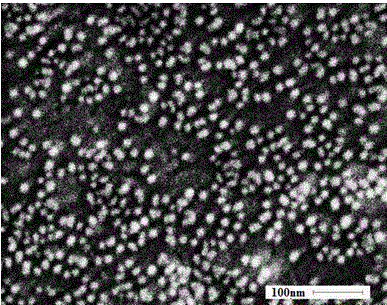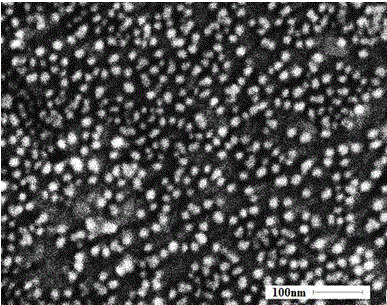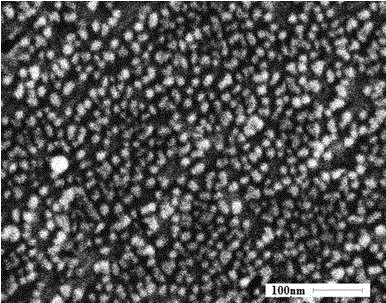High-efficiency synthetic method of nanometer aluminum particle
A synthesis method and nano-aluminum technology, applied in nanotechnology, nanotechnology, aluminum-sulfur compounds, etc., can solve the problems of aluminum particle loss, wide particle size range, large nanoparticle size, etc., and achieve reduction efficiency and yield improvement, Easy extraction and good stability
- Summary
- Abstract
- Description
- Claims
- Application Information
AI Technical Summary
Problems solved by technology
Method used
Image
Examples
Embodiment 1
[0028]Synthesis of hyperbranched polymers: choose the hydrophobic bromine-containing hyperbranched polyether with a branching degree of 20% as the macromolecular initiator, choose copper bromide as the catalyst, and choose hexamethyltriethylenetetramine as the polynitrogen ligand; Put the bromine-containing hyperbranched polyether and copper bromide into a dry reaction test tube, inject tetrahydrofuran into the test tube with a syringe as a medium-grade solvent, and the amount of tetrahydrofuran added is to ensure that the bromine-containing hyperbranched polyether is completely dissolved in it. , and then inject hexamethyltriethylenetetramine dropwise until the solution turns blue, then inject polydiethylamino ethyl methacrylate dropwise; when the temperature of the solution is controlled between 65°C, the reactant Reaction occurs until the viscosity of the solution is 0.18 Pa·s, stop injecting polydiethylamino ethyl methacrylate; after the reaction, further dilute with tetrah...
Embodiment 2
[0033] Synthesis of hyperbranched polymers: choose the hydrophobic bromine-containing hyperbranched polyether with a branching degree of 30% as the macromolecular initiator, choose copper bromide as the catalyst, and choose hexamethyltriethylenetetramine as the polynitrogen ligand; Put the bromine-containing hyperbranched polyether and copper bromide into a dry reaction test tube, inject tetrahydrofuran into the test tube with a syringe as a medium-grade solvent, and the amount of tetrahydrofuran added is to ensure that the bromine-containing hyperbranched polyether is completely dissolved in it. , and then inject hexamethyltriethylenetetramine dropwise until the solution turns blue, then inject polydiethylamino ethyl methacrylate dropwise; when the temperature of the solution is controlled between 70 ° C, the reactant React between them until the viscosity of the solution is 0.20 Pa·s, stop injecting polydiethylamino ethyl methacrylate; after the reaction, further dilute w...
Embodiment 3
[0038] Synthesis of hyperbranched polymers: choose the hydrophobic bromine-containing hyperbranched polyether with a branching degree of 40% as the macromolecular initiator, choose copper bromide as the catalyst, and choose hexamethyltriethylenetetramine as the polynitrogen ligand; Put the bromine-containing hyperbranched polyether and copper bromide into a dry reaction test tube, inject tetrahydrofuran into the test tube with a syringe as a medium-grade solvent, and the amount of tetrahydrofuran added is to ensure that the bromine-containing hyperbranched polyether is completely dissolved in it. , and then inject hexamethyltriethylenetetramine dropwise until the solution turns blue, then inject polydiethylamino ethyl methacrylate dropwise; when the temperature of the solution is controlled between 75 ° C, the reactant Reaction occurs until the viscosity of the solution is 0.22Pa·s, and the injection of polydiethylamino ethyl methacrylate is stopped; after the reaction is c...
PUM
| Property | Measurement | Unit |
|---|---|---|
| Viscosity | aaaaa | aaaaa |
Abstract
Description
Claims
Application Information
 Login to View More
Login to View More - R&D
- Intellectual Property
- Life Sciences
- Materials
- Tech Scout
- Unparalleled Data Quality
- Higher Quality Content
- 60% Fewer Hallucinations
Browse by: Latest US Patents, China's latest patents, Technical Efficacy Thesaurus, Application Domain, Technology Topic, Popular Technical Reports.
© 2025 PatSnap. All rights reserved.Legal|Privacy policy|Modern Slavery Act Transparency Statement|Sitemap|About US| Contact US: help@patsnap.com



